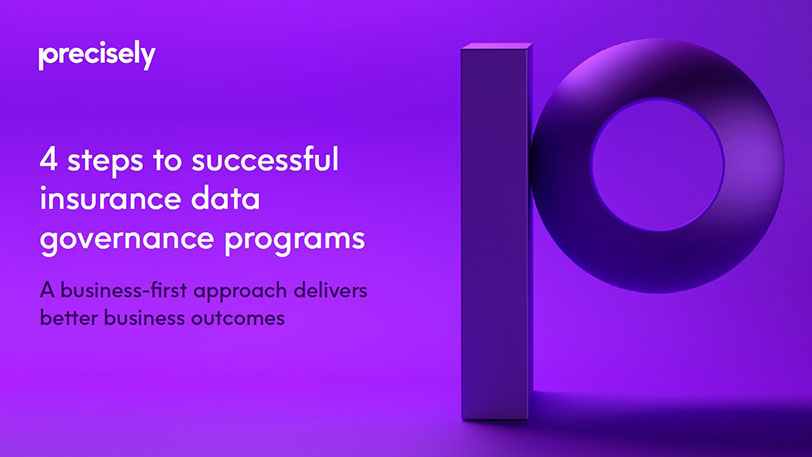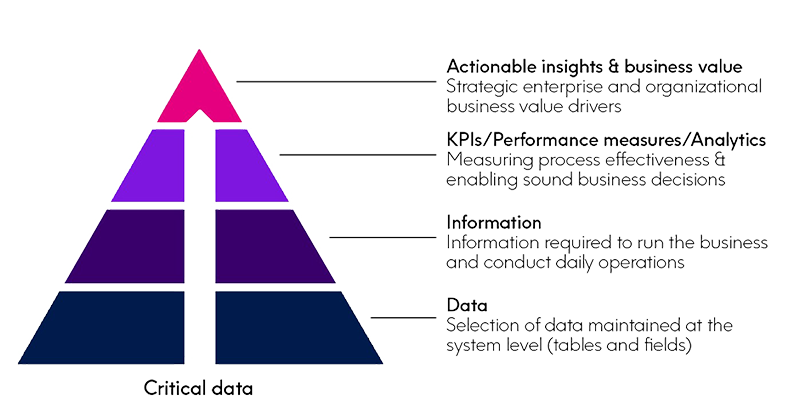eBook
4 Steps to Successful Insurance Data Governance Programs - A business-first approach
Getting started with data governance
Insurance carriers depend on data for all aspects of doing business, from generating sales and making underwriting decisions to servicing policies and settling claims. That’s why leading insurance carriers want what data governance has to offer:
- Improved data quality and integrity
- Data that employees can find and trust for confident decision making
- A framework for owning, managing, monitoring, and deploying compliant data end to end
Unfortunately, traditional insurance data governance initiatives frequently fall short of expectations. That’s because building data governance from the bottom up is difficult
- particularly for insurance carriers with siloed operational departments and multiple locations.
The results too often are overly complex and focused too heavily on governance policies and enforcement. Employees are asked to attend governance meetings, define terms, and change the way they work. Yet often these employees don’t see the connection between data governance and how it makes an impact on meeting their own goals and responsibilities.
Governance strategy becomes bogged down in minutiae. It loses focus. With no tangible improvement in insights, operations, costs, or risk posture — and no clear return on investment — corporate leadership loses enthusiasm. They may even consider defunding governance efforts, losing out on their benefits altogether.

There is a better way: the business-first approach
Start your governance program with a business-first approach that engages employees, quickly delivers some high-value, low-effort wins, and establishes a foundation for growth. It’s been proven to generate between 2x and 7x greater return on investment over a more traditional approach, while delivering results up to 40% faster.
Business-first data governance promotes organizational adoption, lays the foundation for data integrity, and consistently delivers business value over the long term. It increases the likelihood of enterprise-wide expansion of your data governance programs by as much as 75%.
Follow these four steps to realize a business-first approach for your enterprise:
1.) Link data governance to business goals
2.) Prioritize data that matters
3.) Build stakeholder engagement across three tiers
4.) Clear the path for success

Link governance to business goals
A business-first governance strategy identifies corporate goals and initiatives and builds governance capabilities around them.
How does this alignment play out? Suppose that, in an effort to improve customer loyalty, increase revenue through cross-selling, and attract new policyholders, an insurance carrier wants to personalize its products and services. Organizational stakeholders include marketing and sales. Business goals include increasing the net promoter score by 5%, increasing new business from existing policyholders by 17%, and reducing churn by 11%.
Governance objectives in support of these business goals include establishing that elusive “golden” single customer view across all lines of business. Capabilities that governance teams can deploy to meet that objective include:
- Establishing a master customer data file
- Building a data catalog
- Visualizing data lineage of upstream/downstream relationships
- Automating data integrity rules to give appropriate users easy access to data
Precisely helps insurance and financial group centralize its data governance footprint
Established in the 1870s, this long-standing mutual financial group offers investment, retirement, and life insurance products to individuals and employers. The company was using Microsoft SharePoint and Excel to inventory critical financial artifacts in its data governance program.
In order to centralize its data governance footprint, the company needed a solution partner with insurance and financial services expertise, the ability to inventory data lineage of its Markit Enterprise Data Management (EDM) data, and support ownership and administration by data stewards.
Precisely delivered domain expertise along with Precisely’s Data Governance Module. The solution allows the company to access data in Markit EDM and Bloomberg and build its own metadata connectors around other critical data. The company finds that the Data Governance module’s interface is well suited for data steward ownership.

Begin with clearly defined business goals
A good data governance process begins with clearly defined business goals. The insurance industry often breaks these goals into three broad categories: minimize data risk, deliver better data insights, and improve operational processes and decisions.
- Data-related risk minimization is driven by a clear understanding of potential gaps surrounding privacy, security, and compliance. This includes profiling risk exposure, managing the privacy and security of policyholders and agents, internal IT controls, and more.
- Business insights drive business value in targeted marketing, risk reduction, underwriting analytics, claims management, renewals, and more. Analytics help stakeholders in the business to develop a clear 360° understanding of the company’s customers and prospects.
- Operational excellence is about improving cycle times and data quality, while reducing costs in everything that the organization does. This includes policy administration, customer satisfaction, agency and agent management, claims management, expense management, data quality management, and more.
Many of the goals on your list will be driven by the same datasets. For instance, managing the privacy of policyholder data is most likely the same data that helps strategic decision makers gain a 360° view of customers. Those same datasets are likely to impact operational improvements around customer satisfaction or agent management. A critical part of the governance process consists of linking those data assets to your organization’s key business goals and understanding those relationships.
An overarching objective will be establishing a common view of trusted data assets. Specific data governance capabilities such as a data catalog, data lineage, approval workflows, and well-defined data integrity rules can then be identified as components that contribute to achieving that objective.
Prioritize business-focused governance projects for quick wins
By connecting the dots between business objectives and data governance capabilities, you’ll be laying the groundwork for success. But you can’t build your entire enterprise-wide program in your first governance iteration.
To increase the chances of success and to help win advocates for the program, start with low-effort, high-value initiatives that illustrate the value of data governance and produce quick wins. You may want to use this prioritization framework to identify the right projects:
- Reach. Will this new data governance initiative further a corporate-wide initiative such as increasing profitability or establishing a 360° customer view? Or will it just make life easier for the property claims processing division?
- Impact: What impact will the data governance initiative have on your company or its customers? Will it make it faster and easier for hundreds of thousands of new home buyers to get quotes on homeowners insurance? Or will it enable a very low-risk segment of drivers to get slightly better rates on their auto policy renewals?
- Confidence: How sure are you that your governance initiative will help the company meet a specific business goal? Do you have metrics to back up your beliefs?
- Effort: How much governance effort will it take to reach a business goal? How much time will it require? Does your team have the skills needed in-house?

Separate “needs” from “wants” when selecting capabilities
Initial data governance initiatives should separate what capabilities the organization truly needs to reach a specific goal from those capabilities it would simply like to have.
Group data governance components into “must haves” (needs) and “nice to haves” (wants). Anything that supports high-priority goals or is attached to multiple identified business objectives is a “must have.” Anything else is a “nice to have” that can be deployed later.
If your goal is to personalize insurance products and services, “must haves” may include a centralized collection of customer data, a data lineage flow, and automated approval of workflows. “Nice to haves” may include machine learning capabilities that help the business determine whether certain data fields in each customer profile are more trustworthy than others.
Supporting digital transformation with data governance
To keep pace with digital transformation trends in the market, this insurance marketplace initiated a data governance project to better communicate reference data definitions and standards across its network. It faced a number of complexities, including incorporating multiple disparate data feeds and sources, documenting sparsely defined third-party reporting requirements, and replacing its heavy reliance on spreadsheets and PDFs.
Precisely’s Data Governance Module was chosen because of its easy to understand, flexible meta-model, the ability to represent multiple datasets in a single solution, and extensive APIs that connected to other systems. Benefits the company realized include providing a single source of truth on critical market data and enabling their partners with more dynamic metadata.
Prioritize data that matters
The sheer volume of data maintained by insurance carriers today is indeed overwhelming. It includes both structured data such as policy and insured data, claims records, and unstructured data, including emails, documents, PDFs, and images.
The good news is that you don’t have to govern all of it right away.
Precisely estimates that as little as 5% percent of corporate datasets drive 95% of business results by delivering insights, minimizing business risk, and improving operations. Reduce governance time-to-value by concentrating on just that critical data at first. This focus simplifies data governance significantly by limiting the amount of data to be governed in alignment with any single business goal from perhaps thousands of elements to just a few dozen.
By understanding how each data element fits into the business objectives established earlier, data stewards can more easily set priorities by identifying which data points matter and can then focus on governing those that are most important.
Four-tiered data hierarchy
Most insurance carriers operate with a four-tiered hierarchy, with the highest value data at the top of the pyramid.

Build stakeholder engagement across three tiers
The next step is to align stakeholders across the three levels of your organization: tactical (including data management, data science, and product management); operational (including underwriting, claims management, and marketing); and strategic (executive management).
Each of these groups sees business value through a different lens. That means they typically have different methods and metrics by which they determine success or failure. Building stakeholder engagement across all three levels of the organization requires the data governance process to address each group’s needs and concerns.
To do this, build meaningful KPIs measuring:
Current and future-state efficiencies at the tactical level. Data analysts, data scientists, data stewards, data engineers, and others want KPIs that measure improvement in data access and movement, data completeness, and improved curating.
Improved business processes, performance, and scalability at the operational level. Business process leads, data governance leads, data management leads, information architects, and other professionals want KPIs measuring improvement in data quality, reduction in data errors, and reduced cycle times.
ROI and transformation efforts at the strategic level. CEOs, CIOs, CDOs, data and analytics leads, and business transformation leads value KPIs measuring improvement in process enablement, customer satisfaction, and project acceleration, among other benefits.
KPIs must link across organizational levels to tell the complete story of how governance supports an insurance carrier’s business goals. The complete data governance story may run something like this:

Clear the path for success
Finally, an effective data governance initiative will clear the path for success by removing friction from stakeholder processes, helping them to deliver on the desired outcomes. It will make it easy for business teams to contribute to the data governance process, keeping teams engaged and wanting more. And it will create enthusiasm among employees by communicating value and celebrating success.
Governance initiatives depend on stakeholder participation to define key terms (how does a “policyholder” differ from a “customer” or an “account”?), identify baseline measurements, and more. Programs that include personal onboarding conversations, newsletters, and leadership endorsements will gain better traction than those which leave adoption to chance. Self-service solutions such as platform training videos, data integrity dashboards, and progress scorecards provide greater visibility to results and invite participation from a broad group of stakeholders.
Frequent communications and reinforcement from data governance ambassadors can further improve employee engagement. Regular communications keep governance in the forefront of employees’ minds, consistently reminding them of the value that data governance brings to their work. Data governance ambassadors should regularly share insight, report issues, and quantify the impact of changes brought about through governance efforts.
Why Precisely?
Precisely is the global leader in data integrity, providing accuracy and consistency in data for 12,000 customers — including 99 of the Fortune 100 — in more than 100 countries. Precisely’s data governance products establish strong, business-first frameworks to help you better find, understand, and manage data for improved business outcomes.
The Data Governance Module is an enterprise data governance, catalog, and metadata management solution that improves the value, meaning, and trustworthiness of your data. It automates governance and stewardship tasks to help you answer essential questions about your data’s source, use, meaning, ownership, and quality. With Precisely’s Data Governance Module, you can make better, faster data-management decisions, build collaboration across your entire organization, and empower users to get the answers they need, when they need them.
Business goal tracking provides real-time views into how data supports business processes. Dashboards and reports personalize insights about your curated or transactional data with views that connect data to outcomes. The Data Governance Module also provides insight into compliance events and metrics.
Help your company to deploy a data governance strategy that builds employee engagement to minimize risk, increase business insight, and improve operations.
Get started today.
